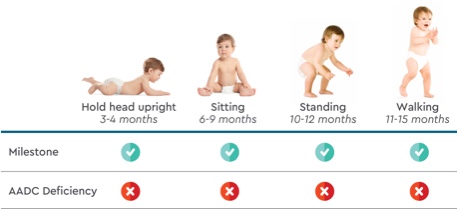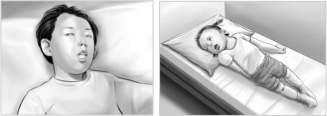Signs and symptoms OF AADC DEFICIENCY
The decrease in that is caused by AADC deficiency may result in a range and severity of symptoms. The most common symptoms include:
Low muscle tone
- Also known as “floppy baby” (hypotonia)

Delays in development, such as in the ability to:
- Lift and control their head
- Babble or say words
- Crawl, sit, or stand without support
- Walk
Key developmental milestones

Developmental milestones achieved in children with AADC deficiency varies from child to child.
Movement problems
- Especially sudden episodes of involuntary and irregular eye movements, called oculogyric crises. During these episodes, a child’s eyes will suddenly roll upward, without control; the episodes can last anywhere from a few seconds to hours, and can happen several times a day or several times a week. These episodes may also include:
- Tongue thrusting and jaw spasms
- Hyperextension of the head, neck, or back
- Contracting muscles and/or twisting involuntarily
- Involuntary muscle contractions, sometimes called dystonia
- Too little movement or movements that are smaller than you would expect, which is also known as hypokinesia

See an oculogryic crisis
View this short video to see what one oculogyric crisis episode looks like. Not all oculogyric crisis episodes may look the same.
Video of Jillian Heger is used with permission from her mother and caregiver, Kelly Heger.
“Every day, at 3 or 4 o’clock, she would arch back, roll her eyes back, and become dystonic. She was stiff. She was uncomfortable. And then I also started saying how she looked like she was having seizures.”

People with AADC deficiency may also show signs of:
- Other involuntary movements, such as sudden jerking, flailing, or twisting
- Excessive sweating
- Drooling
- Drooping eyelids
- Stuffy or running nose
These symptoms may also be present:
- Sleeping problems
- Irritability
- Excessive crying
- Symptoms that become worse or more noticeable later in the day and improve with sleep
- Problems with digestion
- Diarrhea
- Constipation
- Reflux
- Problems with feeding

